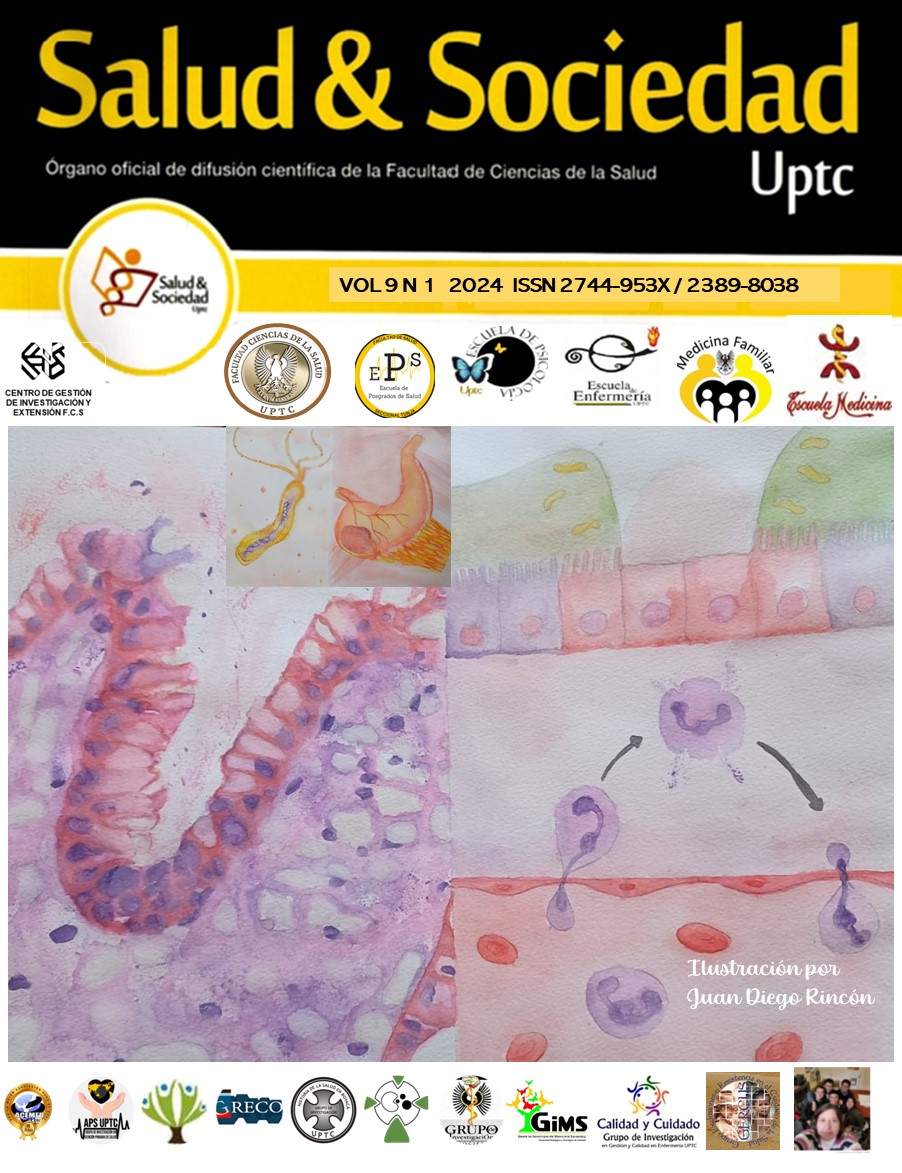Prevalence of nomophobia in UPTC medical students 2023

Abstract
Backup: in recent years, the massive and inappropriate use of mobile phones has caused a considerable increase in the number of mental problems related to technology. Objective: assess the prevalence of nomophobia through the Nomophobia Questionnaire (NMP-Q) (2015), in medical students at the clinical area of the Universidad Pedagògica y Tecnològica de Colombia. Methodology: observational, descriptive cross-sectional study. Population were subjects between 18 and 26 years of age studying medicine at the Pedagogical and Technological University of Colombia; sample: non-probabilistic, sequential by convenience. The Spanish-adapted version of the Nomophobia Scale (NMP-Q) was used, composed of 20 items. Results: significantly higher prevalence of nomophobia with levels of mild 20.0%; Moderate nomophobia 70.0% and severe nomophobia 10.0%. A higher prevalence of severe nomophobia is found in females. Conclusions: These findings reveal a problem that affects all the student’s sample (100%) of this study, made up of young adults. Contrasting these results with previous research highlights a significantly higher prevalence of nomophobia compared to studies that report that 70.76% of the general adult population is affected by this phobia. It is pertinent to note that this could have a substantial impact on various cognitive functions, study habits and even the mental health of students. Conclusion: It is suggested to continue with additional research related to this topic, expanding the sample of students, and seeking the implementation of strategies designed to effectively address this phobia characteristic of the modern era.
Keywords
Medical students, Technology addiction, Mental Health
Author Biography
Lina Margarita Charry Jiménez
Médica Interna, FOSCAL
María Paula Rodríguez Duque
Médica Interna, HRD
Ludy Stefany Oviedo Delgado
Médica Interna, FOSCAL
Ledmar Jovanny Vargas Rodríguez
Médico epidemiologo. Hospital Regional de la Orinoquía
References
- Liu JCJ, Ellis DA. Editorial: Eating in the Age of Smartphones: The Good, the Bad, and the Neutral. Front Psychol. 2021 Dec 6;12:796899. doi: 10.3389/fpsyg.2021.796899. PMID: 34938246; PMCID: PMC8685243.
- León Mejía A , et al. Una revisión sistemática sobre la prevalencia de la nomofobia: resultados a la vista y directrices estándar para futuras investigaciones. PLOS ONE.2021.https://doi.org/10.1371/journal.pone.0250509
- Antoni Aguiló P, Sánchez F, Pareja-Bezares A. Uso del Teléfono Móvil, Estilo de Vida y Bienestar Psicológico en Estudiantes Universitarios [Internet]. 2022. Disponible en:
- Humood A, Altooq N, Altamimi A, Almoosawi H, Alzafiri M, Bragazzi NL, Jahrami H. The Prevalence of Nomophobia by Population and by Research Tool: A Systematic Review, Meta-Analysis, and Meta-Regression. Psych. 2021;3(2):249–258. doi: 10.3390/psych3020019
- Martínez-Hernández N, de-León-Ramírez L, Profet-Naranjo A. Nivel de nomofobia en universitarios cubanos. Progaleno [revista en Internet]. 2023 [citado 23 Sep 2023]; 6 (1) :[aprox. 8 p.]. Disponible en: https://revprogaleno.sld.cu/index.php/progaleno/article/view/407
- Almeida O, Moreno J, Hapuc K, Duarte E, Silva CA. Identificación de la relación existente entre los factores predisponentes y mantenedores en la presencia de nomofobia en los estudiantes de Psicología vinculados a la Corporación Universitaria Minuto de Dios, Bucaramanga. Revista Boletín, REDIPE. 2018;7(10):216-234.
- Disponible en: https://revista.redipe.org/index.php/1/article/view/593/564
- González-Cabrera J, León-Mejía A, Calvete E, Pérez-Sancho C. Adaptación al español del Cuestionario Nomophobia Questionnaire (NMP-Q) en una Muestra de Adolescentes. Actas Españolas de Psiquiatría. 2017;45(4):137–144. pmd:28745386
- Yildirim C. Exploración de las dimensiones de la nomofobia: desarrollo y validación de un cuestionario utilizando métodos de investigación mixtos. Universidad del Estado de Iowa; 2014.
- Augner C, Hacker GW. Association between problematic mobile phone use and psychological parameters in young adults. Int J Public Health. 2012; 57(2): 437-41.
- Daraj LR, AlGhareeb M, Almutawa YM, Trabelsi K, Jahrami H. Revisión sistemática y metanálisis de los coeficientes de correlación entre nomofobia y ansiedad, adicción a los teléfonos inteligentes y síntomas de insomnio. Salud 2023;11:2066. https://doi.org/10.3390/healthcare11142066.
- Fulkerson J.A., A Loth K., Bruening M., Berge J.M., Eisenberg M.E., Neumark-Sztainer D. Time 2 tlk 2nite: Use of electronic media by adolescents during family meals and associations with demographic characteristics, family characteristics, and foods served. J. Acad. Nutr. Diet. 2013;114:1053–1058. doi:
- 1016/j.jand.2013.10.015.
- Schwaiger, E. y Tahir, R. (2022). El impacto de la nomofobia y la presencia de teléfonos inteligentes en la inteligencia y la atención fluidas. Ciberpsicología: Revista de investigación psicosocial sobre el ciberespacio , 16 (1), artículo 5. https://doi.org/10.5817/CP2022-1-5
- Smetaniuk P. A preliminary investigation into the prevalence and prediction of problematic cell phone use. J Behav Addict. 2014; 3(1): 41-53.
- Oto E, Barrero L, Arezes A, Barrena N, Barrena S, Bonilla A. Nomofobia, articulo monográfico. Revista sanitaria de investigación, 2022. Disponible [en línea]: https://revistasanitariadeinvestigacion.com/nomofobia-articulo-monografico/
- León Mejía A. Nomofobia: Revisión de la literatura y desarrollo de la versión española del Nomophobia Questionnaire (NMP-Q). Universidad de Salamanca. Septiembre, 2021. Disponible [en línea]:
